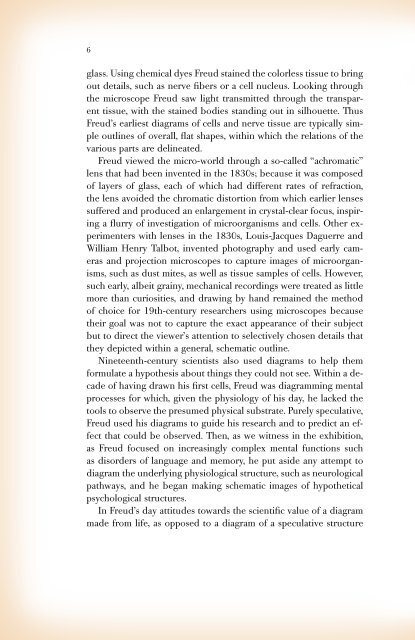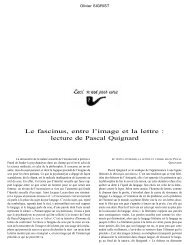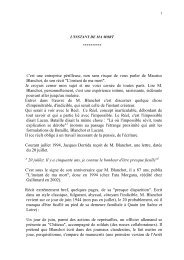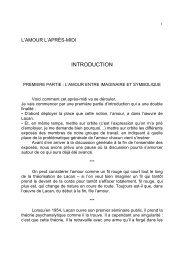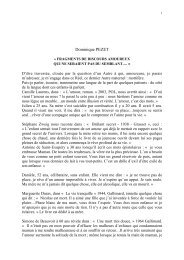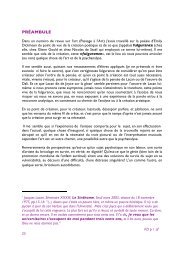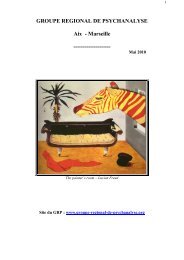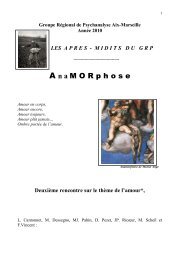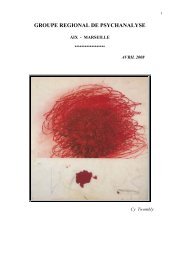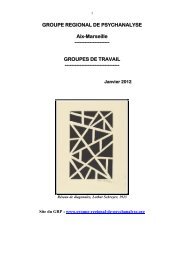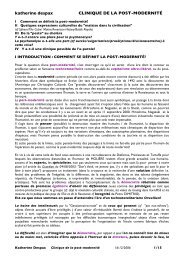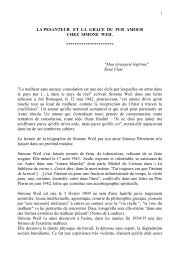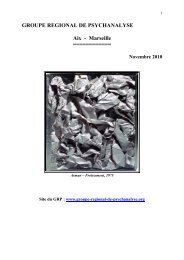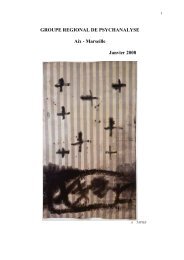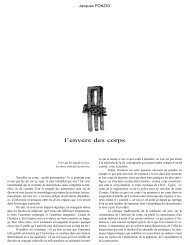freud book for pdf.indd - groupe régional de psychanalyse
freud book for pdf.indd - groupe régional de psychanalyse
freud book for pdf.indd - groupe régional de psychanalyse
You also want an ePaper? Increase the reach of your titles
YUMPU automatically turns print PDFs into web optimized ePapers that Google loves.
6 7<br />
glass. Using chemical dyes Freud stained the colorless tissue to bring<br />
out <strong>de</strong>tails, such as nerve fibers or a cell nucleus. Looking through<br />
the microscope Freud saw light transmitted through the transparent<br />
tissue, with the stained bodies standing out in silhouette. Thus<br />
Freud’s earliest diagrams of cells and nerve tissue are typically simple<br />
outlines of overall, flat shapes, within which the relations of the<br />
various parts are <strong>de</strong>lineated.<br />
Freud viewed the micro-world through a so-called “achromatic”<br />
lens that had been invented in the 1830s; because it was composed<br />
of layers of glass, each of which had different rates of refraction,<br />
the lens avoi<strong>de</strong>d the chromatic distortion from which earlier lenses<br />
suffered and produced an enlargement in crystal-clear focus, inspiring<br />
a flurry of investigation of microorganisms and cells. Other experimenters<br />
with lenses in the 1830s, Louis-Jacques Daguerre and<br />
William Henry Talbot, invented photography and used early cameras<br />
and projection microscopes to capture images of microorganisms,<br />
such as dust mites, as well as tissue samples of cells. However,<br />
such early, albeit grainy, mechanical recordings were treated as little<br />
more than curiosities, and drawing by hand remained the method<br />
of choice <strong>for</strong> 19th-century researchers using microscopes because<br />
their goal was not to capture the exact appearance of their subject<br />
but to direct the viewer’s attention to selectively chosen <strong>de</strong>tails that<br />
they <strong>de</strong>picted within a general, schematic outline.<br />
Nineteenth-century scientists also used diagrams to help them<br />
<strong>for</strong>mulate a hypothesis about things they could not see. Within a <strong>de</strong>ca<strong>de</strong><br />
of having drawn his first cells, Freud was diagramming mental<br />
processes <strong>for</strong> which, given the physiology of his day, he lacked the<br />
tools to observe the presumed physical substrate. Purely speculative,<br />
Freud used his diagrams to gui<strong>de</strong> his research and to predict an effect<br />
that could be observed. Then, as we witness in the exhibition,<br />
as Freud focused on increasingly complex mental functions such<br />
as disor<strong>de</strong>rs of language and memory, he put asi<strong>de</strong> any attempt to<br />
diagram the un<strong>de</strong>rlying physiological structure, such as neurological<br />
pathways, and he began making schematic images of hypothetical<br />
psychological structures.<br />
In Freud’s day attitu<strong>de</strong>s towards the scientific value of a diagram<br />
ma<strong>de</strong> from life, as opposed to a diagram of a speculative structure<br />
or hypothetical process, reflected traditional philosophical <strong>de</strong>bates<br />
about where reality lies. The Enlightenment philosophers John<br />
Locke and David Hume were British Empiricists who held that<br />
one can only know with certainty what one experiences directly<br />
— seeing is believing. In the wake of the French Revolution, early<br />
19th-century social re<strong>for</strong>mers in France and Britain first expressed<br />
the outlook of positivism: science gives the only valid (“positive”)<br />
knowledge. Scientists imported these attitu<strong>de</strong>s into 19th-century<br />
British and French laboratories where researchers shunned theory<br />
and only trusted direct observation, perhaps ai<strong>de</strong>d by a microscope.<br />
Thus pictures drawn through a microscope were welcome in the<br />
halls of science in London and Paris, but theoretical diagrams of<br />
hypothesized, unseen realms were dismissed with disdain.<br />
In Germany, however, Enlightenment philosophy had culminated<br />
at the close of the 18th century with Immanuel Kant’s critiques of<br />
the foundations of human knowledge in which he <strong>de</strong>clared that one<br />
only knows with certainty the contents of one’s own mind, or “i<strong>de</strong>as.”<br />
According to Kant’s German I<strong>de</strong>alism, it is physically impossible <strong>for</strong><br />
a scientist to observe the natural world directly because one knows<br />
flowers and songbirds only as mental constructions ma<strong>de</strong> out of<br />
sensory appearances (colors, sounds). As science <strong>de</strong>veloped in<br />
Germanic culture, many researchers adopted this outlook and treated<br />
sensations of colors and shapes as signs of an ultimately unknowable<br />
world-out-there (Kant’s so-called “thing-in-itself”). Thus German<br />
researchers were com<strong>for</strong>table using theoretical mo<strong>de</strong>ls such as<br />
diagrams of unseen realms to gui<strong>de</strong> their investigations. But as the<br />
scientific method gradually replaced philosophical <strong>de</strong>bate, in or<strong>de</strong>r<br />
to be confirmed a theory had to predict results that were observable<br />
by all. Thus in German laboratories drawings <strong>de</strong>picting what was<br />
seen through a microscope became one method of providing the<br />
indispensable observation that supported and helped to confirm a<br />
theoretical mo<strong>de</strong>l.<br />
It was researchers working within this German-speaking scientific<br />
community who led the investigation of the inherently unobservable<br />
human psyche. The leading German scientist of the second half<br />
of the 19th century, Hermann von Helmholtz, groun<strong>de</strong>d Kant’s<br />
i<strong>de</strong>alist view of human knowledge in the body by <strong>de</strong>monstrating,


